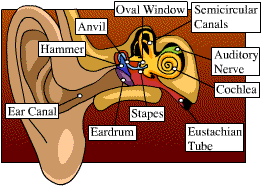Hearing the World Around Us
Created | Updated Dec 8, 2005

Our perception of the world around us depends upon the ability of biological apparatuses, known as our 'senses', to extract particular physical and/or chemical features from the environment and present them in a meaningful way to our brain. There are, for the purposes of this discussion, five senses: vision, hearing, taste, smell, and touch.
These sensory systems have several important design features in common. First, they must be selective for particular stimuli. For example, normally you don't hear a colour unless you've really been dipping into the old lysergic acid. They also must be fast; it won't do you any good if it takes you five minutes to realise that you are, in fact, on fire. Sensory systems must also be sensitive to small changes in stimulus parameters, and they must be reliable in their ability to detect a relevant signal from background noise. Finally, sensory systems must be able to transmit their information to the brain with a high degree of fidelity.
What Is Sound?
All sounds are essentially pressure waves of a particular frequency. Imagine a sine wave (think of an 'S' laying on its side); it takes a finite amount of time for a full cycle (measured peak-to-peak, for example) of the wave to occur. The more cycles you can cram into a given time frame, the higher that wave's frequency. The frequency of these waves (generally measured in cycles per second or 'Hertz') determines the pitch of the sound we experience. The higher the frequency, the higher the pitch. Here's a tangible example; the A above middle C on a piano has a frequency of 440 cycles per second.
The Biology of Hearing
In order for us to hear, sound waves must be converted into the electrochemical energy that our nervous system uses for communication. This must be done so that the features of a particular sound are retained, or at the least, can be reconstructed by our brain. These features include frequency (pitch), intensity (loudness) and timing.
In order to accomplish this, our ears collect sound waves of all frequencies using the outer ear and transmit them via the tympanic membrane (ear drum) to the middle ear. This air-filled cavity is bounded by the ear drum on the outside and the ossicles on the inside. The ossicles are a series of three fine bones, linked together and that fit into a small opening called the oval window which is at the base of the cochlea. These bones transform small changes in the air pressure of the middle ear into pressure variations in the fluid-filled inner ear, also known as the cochlea.
The cochlea is an extremely delicate organ. In humans, it is a fluid-filled, spiral-shaped structure of nearly three turns, which is buried in the hardest bone of the body, the temporal bone of the heads. In fact, it looks a lot like a snail shell. Small cells embedded in the basal membrane of the cochlea extend tiny finger-like projections (stereocilia) into the fluid and are contacted by an overlying membrane (the tectorial membrane). These projections are called 'hair bundles' because they look like tiny tufts of hair on the tops of the cell. They also give these cells their name: hair cells.
When sound waves are presented, the fluid in the cochlea moves and the hair bundles on top of the hair cells are bent slightly by the tectorial membrane. This literally pulls opens a small pore in the cell, allowing a current to flow. It is the job of the hair cell to integrate this current and then transmit it to the nerves that then ascend to the brain.
Each hair cell in the cochlea has its favourite frequency, the one that makes it just fire away blissfully. This is called 'tuning'. The hair cells are organised along the length of the cochlea so that there is a gradient of cells that like the same or similar frequencies clustered together. When a particular sound arrives at the ear, it is basically broken down according to its frequency components as it is being transduced to the auditory nerves. From here, the brain integrates these signals to reconstruct complex sound such as speech or opera.
Repairing Broken Ears
Humans typically identify vision as their most prized sense. Yet, it is generally thought that blindness cuts people off from the world of things, while deafness cuts people off from the world of people. This is because so much of human communication is based upon speech and its perception. To this end, great efforts are being made to restore hearing to the deaf.
One approach is to literally replace defective proteins which prevent the hair cells of the ear from functioning properly with new proteins using engineered viruses. The hope is that once these 'healthy' proteins are in place, the hair cells may once again be able to transduce sound to the rest of the hearing apparatus which remains normal. This type of approach could actually prevent deafness from ever occurring in some diseases.
Another approach is to use 'cochlear implants' to restore hearing to totally deaf individuals. Cochlear implants are arrays of electrodes which are implanted in the inner ear and are used to stimulate the nerves in response to sound. This essentially recreates the normal distribution of neural activity that occurs in a 'hearing' ear.
These represent two vastly different approaches to repair different causes of deafness. While cochlear implants are used successfully for some people, in others, congenital defects have destroyed the hearing apparatus entirely. For these people, it is hoped that gene therapy may one day be able to allow them to hear the world around them.

